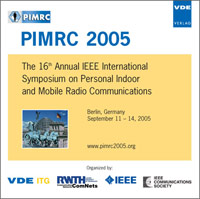On Second Order Statistics of the Satellite-to-Indoor Channel Based on Field Measurements
Conference: PIMRC 2005 - 16th Annual IEEE International Symposium on Personal Indoor and Mobile Radio Communications
09/11/2005 - 09/14/2005 at Berlin, Germany
Proceedings: PIMRC 2005
Pages: 5Language: englishTyp: PDF
Personal VDE Members are entitled to a 10% discount on this title
Authors:
Lakhzouri, Abdelmonaem; Lohan, Elena Simona; Renfors, Markku (Institute of Communications Engineering, Tampere University of Technology, PO Box 553, 33101, Finland)
Saastamoinen, Ilkka (u-Nav Microelectronics, Hermiankatu 6-8 D, 33720, Tampere Finland)
Abstract:
Wireless positioning has received increased attention during the past few years, where several wireless applications have been envisaged and promoted such as the E-911/E-112 regulations. The positioning needs to be carried out in all the environments covered by the wireless communication services, including the most constraining areas such as dense urban areas and obstructed indoor environments. The most known positioning system is the Global Navigation Satellite System (GNSS), which demonstrated quite reliable positioning capabilities when the receiver is in direct view with the sky. However, in indoor environments the signal characteristics are not well understood yet and positioning capabilities are quite poor. Therefore, understanding the multipath propagation indoors and fading characteristics are quite important to make GNSS works indoors. In this paper, we describe measurement-based modeling results of the level-crossing rate (LCR) and average duration of fades (ADF) with the purpose of giving further insight on the real satellite-to-indoor channel characteristics.


